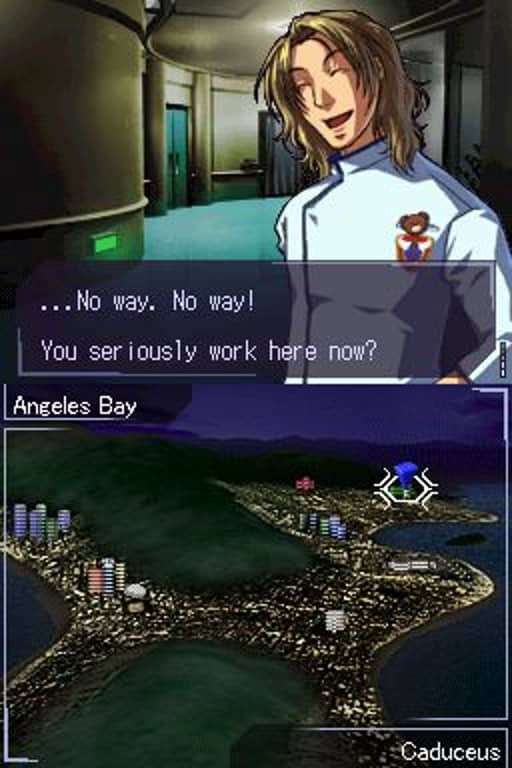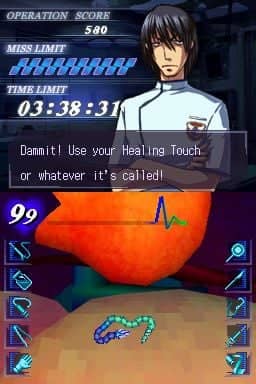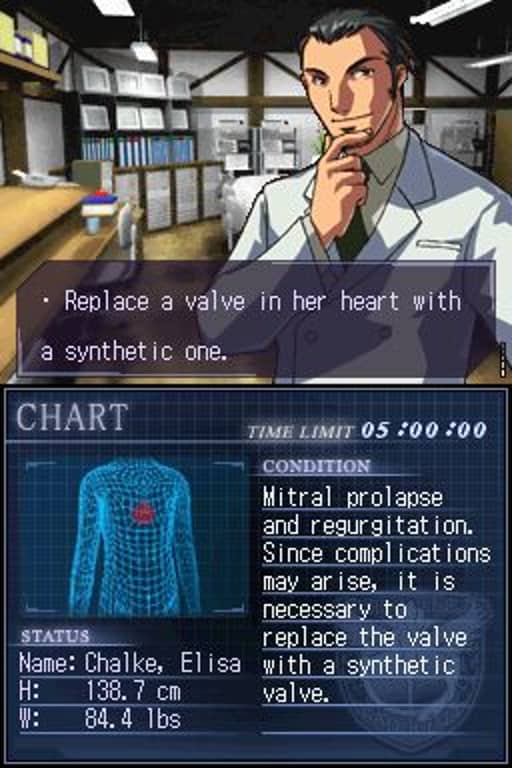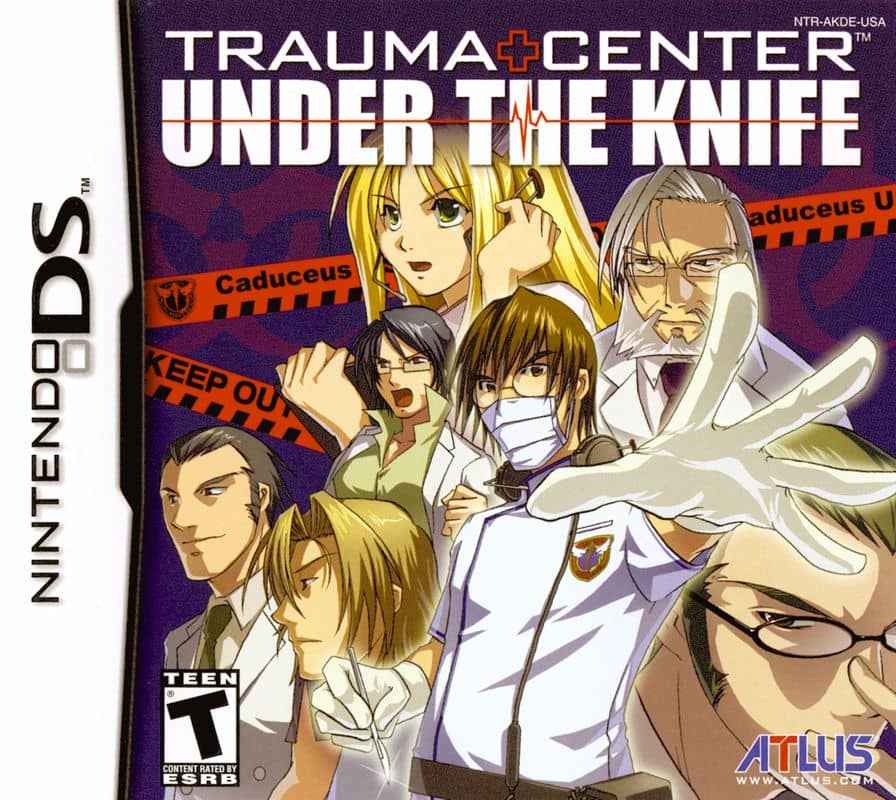Trauma Center: Under The Knife
Released: June 16, 2005 (JP), October 4, 2005 (US), April 28, 2006 (EU)
Publisher(s): ATLUS
Platform(s):


Completed on Nintendo 3DS.
HowLongToBeat Time: 8 hours | My Clear Time: 6 hours 54 mins.
Background
Trauma Center: Under the Knife, known in Japan as Choushittou Caduceus, is a medical simulation video game developed and published by Atlus for the Nintendo DS in 2005. It was one of the early titles for the Nintendo DS that utilized the touchscreen and stylus functionality in innovative ways. The original planning was spearheaded by producer Katsura Hashino, known for his work on titles like SMT: If, Devil Summoner, and Persona 3.
The development team, which included veteran staff from the Megami Tensei series, collaborated closely with real surgeons to ensure the game’s medical procedures were authentic and realistic (Hashino, 2006). The team also drew inspiration from western TV shows such as ER and Chicago Hope. Additionally, renowned composer Shoji Meguro contributed to the game’s soundtrack (Nintendo Inside, 2005).

Experience
Prior to playing Trauma Center: Under The Knife, I’ve had the pleasure of completing numerous Atlus titles, such as Persona 2: Innocent Sin, Persona 3: FES, Persona 3: Portable, Persona 4: Golden, Persona 5, Shin Megami Tensei III: Nocturne Maniax, Shin Megami Tensei IV, Shin Megami Tensei V, Shin Megami Tensei: Soul Hackers, Shin Megami Tensei: Devil Survivor Overclocked, Shin Megami Tensei: Soul Hackers 2, Shin Megami Tensei: Strange Journey Redux, Devil Summoner: Raidou Kuzunoha vs. the Soulless Army, Jack Bros., Catherine, Tokyo Mirage Sessions #FE Encore, and more. I’ve attempted to play Trauma Center: Under The Knife before, but it was on an emulator, and I struggled to make the mouse function well as a substitute for the DS’s touch screen.

Impressions
Having previously attempted to play the game on non-native hardware, I grew frustrated and set it aside from the end of 2019 until yesterday. This time, I played it on the Nintendo 3DS and completed it this morning, clocking in at a clear time of 6 hours, 54 minutes, and 12 seconds.
The soundtrack of Trauma Center was remarkable, featuring a variety of compositions from upbeat jingles to dramatic, high-tempo pieces accompanied by organs, effectively setting the tone for the game’s drama.
The use of the stylus is exceptionally well-thought-out, contributing to the game’s immersion rather than feeling like a gimmick or hindrance. Your performance in each operation determines your rank, factoring in completion time, the patient’s remaining life, and additional points earned. Though it’s easy to get stuck with a C rank, I’m fortunate to say I haven’t received anything lower during my playthrough.
The dialogue captures the banter typical of medical shows, adding authenticity to both the dialogue and the technical precision and depth required in the operations themselves. With an arsenal of tools at your disposal—medical gel, surgical laser, sutures, drainer, bandages, forceps, and more—the game truly evokes the feeling of being in medical school.
However, despite Trauma Center excelling in many aspects, it begins to falter in the last chapter due to a shift from an engaging and personal tale of growth and determination to a focus on rushing through nameless and faceless patients as a finale boss rush. This change diminishes the impact of the narrative and detracts from the overall experience.

Verdict
My recent playthrough of Trauma Center: Under the Knife on the Nintendo 3DS provided a fulfilling experience, following a hiatus since the end of 2019. Completing the game this morning in 6 hours, 54 minutes, and 12 seconds underscored its immersive qualities and engaging gameplay mechanics.
The game’s soundtrack stood out with its diverse compositions, effectively setting the tone for the dramatic surgical scenarios. Additionally, the integration of the stylus mechanics felt seamless, enhancing immersion rather than detracting from it.
I found the ranking system, which evaluates performance based on various factors, to be both challenging and rewarding. Despite the potential difficulty in achieving higher ranks, I maintained at least a C rank throughout my playthrough.
The authenticity of the dialogue and the depth of detail in the surgical procedures further immersed me in the game’s world. With a plethora of tools at my disposal, Trauma Center effectively simulated the experience of being in medical school.
However, the game’s narrative faltered in the last chapter, shifting focus from a compelling personal tale to a rushed boss rush finale with nameless patients. This change diminished the impact of the narrative and detracted from the overall experience.
TLDR
Rating: 7.5/10
In Summary: Trauma Center: Under the Knife offers engaging gameplay, an immersive presentation, and a challenging ranking system. However, it suffers from a narrative shift in the final chapter and potential difficulty in maintaining higher ranks.
References
- Hashino, K. (2006, August 24). Supersurgery Caduceus. Wayback Machine. https://web.archive.org/web/20060824062232/http://www.atlus.co.jp/cs/game/ds/kad/column/column001.html
- Nintendo Inside. (2005, April 16). Special Report – Supersurgical Caduceus. https://web.archive.org/web/20060708212635/http://nintendo-inside.jp/special/caduceus/interview.html



Leave a Reply